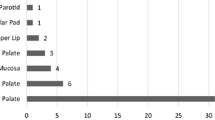Abstract
Papillary salivary gland neoplasms are rare tumors usually arising in the minor salivary glands of the oral cavity. Their classification has been historically confusing due to overlapping histologic features, but molecular analysis may clarify these entities. Sialadenoma papilliferum (SP) is a peculiar member of this group that demonstrates both an endophytic ductal and an exophytic squamous component. SP closely resembles syringocystadenoma papilliferum of the skin, a tumor which has recently been shown to harbor BRAF V600E or HRAS mutations. We sought to perform histologic and immunophenotypic analysis of a group of SP, along with BRAF and HRAS mutational analysis. We collected 13 SP cases from 7 females and 6 males ranging from 2 to 91 years (mean 62.8). Five exophytic ductal papillomas were also analyzed as controls. Histological analysis was performed along with immunohistochemistry for CK7, p63, and SOX10. BRAF VE1 immunohistochemistry was done in all tumors, and BRAF V600E and HRAS Sanger sequencing was successfully performed in all but two cases. Histologic analysis revealed that SP consisted not only of classic SP (9 of 13 cases) but also an oncocytic variant (4 of 13 cases) characterized by a glandular component that uniformly exhibited abundant granular cytoplasm and prominent nucleoli. By immunohistochemistry, all SP demonstrated luminal CK7 and basal p63 expression, but SOX10 was expressed only in conventional SP (9 of 9 cases). BRAF VE1 immunohistochemistry was positive in 9 of 9 conventional SP but 0 of 4 oncocytic SP; staining was present in both the exophytic and endophytic components. BRAF V600E mutational status was confirmed by Sanger sequencing in 11 cases (7 conventional and 4 oncocytic). The exophytic ductal papillomas were negative for BRAF mutations, and all tumors tested were negative for HRAS mutations. In summary, we demonstrated that SP consists of two variants: (1) conventional SP which is SOX10-positive and harbors BRAF V600E mutations similar to syringocystadenoma papilliferum of the skin; and (2) an oncocytic variant which is SOX10-negative and negative for BRAF mutations. We also demonstrated that both the endophytic glandular component and exophytic squamous components of conventional SP harbor BRAF V600E mutations and are therefore neoplastic.



Similar content being viewed by others
References
Fowler CB, Damm DD. Sialadenoma papilliferum: analysis of seven new cases and review of the literature. Head Neck Pathol. 2018;12:193–201.
Ellis GL, Auclair PL. Sialadenoma papilliferum. AFIP atlas of tumor pathology: tumors of the salivary glands. Washington, DC: ARP Press; 2008. p. 148–51.
Abrams AM, Finck FM. Sialadenoma papilliferum. A previously unreported salivary gland tumor. Cancer. 1969;24:1057–63.
Maiorano E, Favia G, Ricco R. Sialadenoma papilliferum: an immunohistochemical study of five cases. J Oral Pathol Med. 1996;25:336–42.
Antonescu CR, Katabi N, Zhang L, et al. EWSR1-ATF1 fusion is a novel and consistent finding in hyalinizing clear-cell carcinoma of salivary gland. Genes Chromosomes Cancer. 2011;50:559–70.
Behboudi A, Enlund F, Winnes M, et al. Molecular classification of mucoepidermoid carcinomas-prognostic significance of the MECT1-MAML2 fusion oncogene. Genes Chromosomes Cancer. 2006;45:470–81.
Seethala RR, Dacic S, Cieply K, et al. A reappraisal of the MECT1/MAML2 translocation in salivary mucoepidermoid carcinomas. Am J Surg Pathol. 2010;34:1106–21.
El Hallani S, Udager AM, Bell D, et al. Epithelial-myoepithelial carcinoma: frequent morphologic and molecular evidence of preexisting pleomorphic adenoma, common HRAS mutations in PLAG1-intact and HMGA2-intact cases, and occasional TP53, FBXW7, and SMARCB1 alterations in high-grade cases. Am J Surg Pathol. 2018;42:18–27.
Chiosea SI, Miller M, Seethala RR. HRAS mutations in epithelial-myoepithelial carcinoma. Head Neck Pathol. 2014;8:146–50.
Sato M, Yamamoto H, Hatanaka Y, et al. Wnt/beta-catenin signal alteration and its diagnostic utility in basal cell adenoma and histologically similar tumors of the salivary gland. Pathol Res Pract. 2018;214:586–92.
Agaimy A, Mueller SK, Bumm K, et al. Intraductal papillary mucinous neoplasms of minor salivary glands With AKT1 p.Glu17Lys mutation. Am J Surg Pathol. 2018;42:1076–82.
Konstantinova AM, Kyrpychova L, Nemcova J, et al. Syringocystadenoma papilliferum of the anogenital area and buttocks: a report of 16 cases, including human papillomavirus analysis and HRAS and BRAF V600 mutation studies. Am J Dermatopathol. 2019;41:281–5.
Levinsohn JL, Sugarman JL, Bilguvar K, et al. Somatic V600E BRAF mutation in linear and sporadic syringocystadenoma papilliferum. J Invest Dermatol. 2015;135:2536–8.
Persson M, Andren Y, Mark J, et al. Recurrent fusion of MYB and NFIB transcription factor genes in carcinomas of the breast and head and neck. Proc Natl Acad Sci USA. 2009;106:18740–4.
Mitani Y, Liu B, Rao PH, et al. Novel MYBL1 gene rearrangements with recurrent MYBL1-NFIB fusions in salivary adenoid cystic carcinomas lacking t(6;9) translocations. Clin Cancer Res. 2016;22:725–33.
Skalova A, Vanecek T, Sima R, et al. Mammary analogue secretory carcinoma of salivary glands, containing the ETV6-NTRK3 fusion gene: a hitherto undescribed salivary gland tumor entity. Am J Surg Pathol. 2010;34:599–608.
Weinreb I, Zhang L, Tirunagari LM, et al. Novel PRKD gene rearrangements and variant fusions in cribriform adenocarcinoma of salivary gland origin. Genes Chromosomes Cancer. 2014;53:845–56.
Weinreb I, Piscuoglio S, Martelotto LG, et al. Hotspot activating {PRKD}1 somatic mutations in polymorphous low-grade adenocarcinomas of the salivary glands. Nat Genet. 2014;46:1166–9.
Hsieh MS, Lee YH, Chang YL. SOX10-positive salivary gland tumors: a growing list, including mammary analogue secretory carcinoma of the salivary gland, sialoblastoma, low-grade salivary duct carcinoma, basal cell adenoma/adenocarcinoma, and a subgroup of mucoepidermoid carcinoma. Hum Pathol. 2016;56:134–42.
Ohtomo R, Mori T, Shibata S, et al. SOX10 is a novel marker of acinus and intercalated duct differentiation in salivary gland tumors: a clue to the histogenesis for tumor diagnosis. Mod Pathol. 2013;26:1041–50.
Author information
Authors and Affiliations
Corresponding author
Ethics declarations
Conflicts of interest
The authors declare that they have no conflicts of interest.
Additional information
Publisher's Note
Springer Nature remains neutral with regard to jurisdictional claims in published maps and institutional affiliations.
Rights and permissions
About this article
Cite this article
Hsieh, MS., Bishop, J.A., Wang, YP. et al. Salivary Sialadenoma Papilliferum Consists of Two Morphologically, Immunophenotypically, and Genetically Distinct Subtypes. Head and Neck Pathol 14, 489–496 (2020). https://doi.org/10.1007/s12105-019-01068-4
Received:
Accepted:
Published:
Issue Date:
DOI: https://doi.org/10.1007/s12105-019-01068-4




